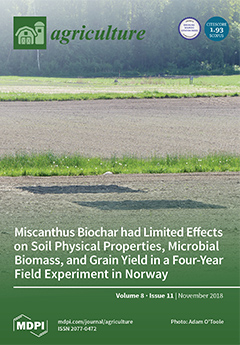Technological change has been the major driving force for increasing agricultural productivity and promoting agriculture development in developing countries. To improve the agricultural productivity and farmers’ livelihoods, several agricultural technologies (improved crop varieties and related agricultural practices) were introduced by various agencies to the farmers in the Rift Valley of Ethiopia. Thus, the objective of this study is to identify these technologies, and evaluate their characteristics and sustainability. The data were collected from farmers, agricultural extension workers, and agricultural experts, through a series of focus group discussions, key informant interviews, and farm observations, selected through purposive and random sampling techniques. Results showed that extension systems, social networks, or research projects were the agencies that introduced the technologies to the farmers. Haricot beans (
Phaseolus vulgaris L.) and early and mid-maturing maize (
Zea mays L.), as well as agricultural practices like row-sowing, banding fertilizer application, intercropping, and traditional rainwater-harvesting, were found to be in continuous use by the farmers. In contrast, the use of extra-early-maturing maize, sorghum (
Sorghum bicolor L.) and finger millet (
Eleusine coracana L.), as well as the use of related practices, including harvesting maize at physiological maturity, seed priming and fertilizer microdosing, were the technologies that were discontinued at the time of pursuing this study. Most of the continuing technologies had a high potential for reducing the vulnerability of the rain-fed agriculture to rainfall variability. Regardless of sources, the national extension system supported technologies that were integrated into the system only. Most of the discontinued technologies were found to be introduced by the research projects. These technologies were not brought into the attention of policy-makers for their integration into the extension system. The farmers also disliked a few of them for unfitting the existing socioeconomic setting. Whereas, the technologies that were introduced by the social networks were found to be widely used by the farmers, though they were not supported by the extension system. This is because most such technologies offer better yield and income. For instance, social networks have popularized haricot beans and hybrid maize because of their higher benefits to farmers. Farmers consider both socioeconomic and agroecological conditions for selecting and using technologies, whereas the extension system centers on existing agroecological conditions for recommending and supporting agricultural technologies. Consideration of both socioeconomic and agroecological settings would increase the prospect of a technology for sustainable adoption. Overall, rainfall variability, high price and poor access to improved seeds, farmers’ poor economic conditions, and the inadequate linkage between extension systems, social networks and research projects, remain critical factors influencing the sustainable use of agricultural technologies. It is, thus, commendable that policymakers should consider local socioeconomic and agroecological settings in recommending and supporting agricultural technologies besides instituting a strong consortium of extension systems, research institutes, research projects, social networks and farmers for improved agricultural technology development, extension system and sustainable adoption.
Full article





